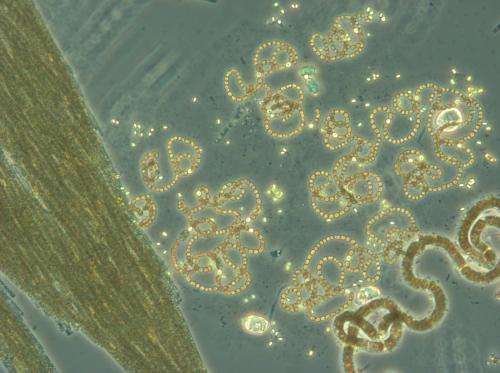Cyanobacteria. Credit: Minna Ylä-Jarkko
The nutrition available for fish in the northern Baltic Sea has become lighter during the past 30 years.
"The amount of energy available for planktivorous organisms has declined after the late 1970s, as both the food quality of phytoplankton and the mean size of zooplankton have decreased", says senior researcher Sanna Suikkanen from Marine Research Centre at the Finnish Environment Institute.
"The observed change is probably due to complex interactions between climate warming, eutrophication and overfishing."
The study is based on analysis of plankton data originating from the northern Baltic Sea, collected by the Finnish Marine Research Institute, Finnish Environment Institute and Finnish Meteorological Institute during late-summer HELCOM monitoring cruises 1979-2011. In addition to the Gulf of Finland and Åland Sea, also the northern Baltic proper was monitored. The aim was to investigate long-term changes in plankton communities and the environmental factors affecting them. The study was performed as a collaboration between Finnish Environment Institute, Research and Development Institute Aronia and University of Sassari, Italy.
"The most significant change affecting plankton communities in the whole study area is the remarkable increase in late summer surface water temperatures. At the same time, salinity decreased in the Baltic proper. On the other hand, concentrations of dissolved inorganic nutrients increased especially in the Gulf of Finland, which indicates eutrophication."
Increased amount, decreased quality
Several changes were observed in the phytoplankton communities, mostly due to warming and eutrophication. Many species increased, which could be seen in the rise of chlorophyll a concentrations and amount of total phytoplankton. Cyanobacteria, haptophytes and chrysophytes increased in the entire study area. Cryptophytes, on the other hand, decreased in the whole area.
Due to the lower nutritional quality of cyanobacteria and haptophytes, compared to cryptophytes, the food quality for zooplankton has declined despite the general increase of phytoplankton.
Both cyanobacteria and haptophytes, as well as the dinoflagellates that increased in the northern Baltic proper, include many potentially toxic or otherwise harmful species.
Less energy available for fish
In the zooplankton communities, there was an increase of small-sized rotifers, but a decrease of total abundance of zooplankton and especially adult and large cladocerans and copepods. The proportion of younger and smaller individuals in the zooplankton community increased. In practice this means that the amount of energy available for e.g. fish has declined.
"It seems that the large-sized zooplankton of the northern Baltic are suffering from changes in the phytoplankton communities, combined with other stressors, such as climate warming, decrease of salinity and increase of planktivorous fish, caused by e.g. overfishing of the large predatory fish", says Sanna Suikkanen.
More information: Suikkanen, S. et al. (2013) Climate Change and Eutrophication Induced Shifts in Northern Summer Plankton Communities. PLoS ONE 8(6): e66475. doi:10.1371/journal.pone.0066475
Journal information: PLoS ONE
Provided by Finnish Environment Institute
























